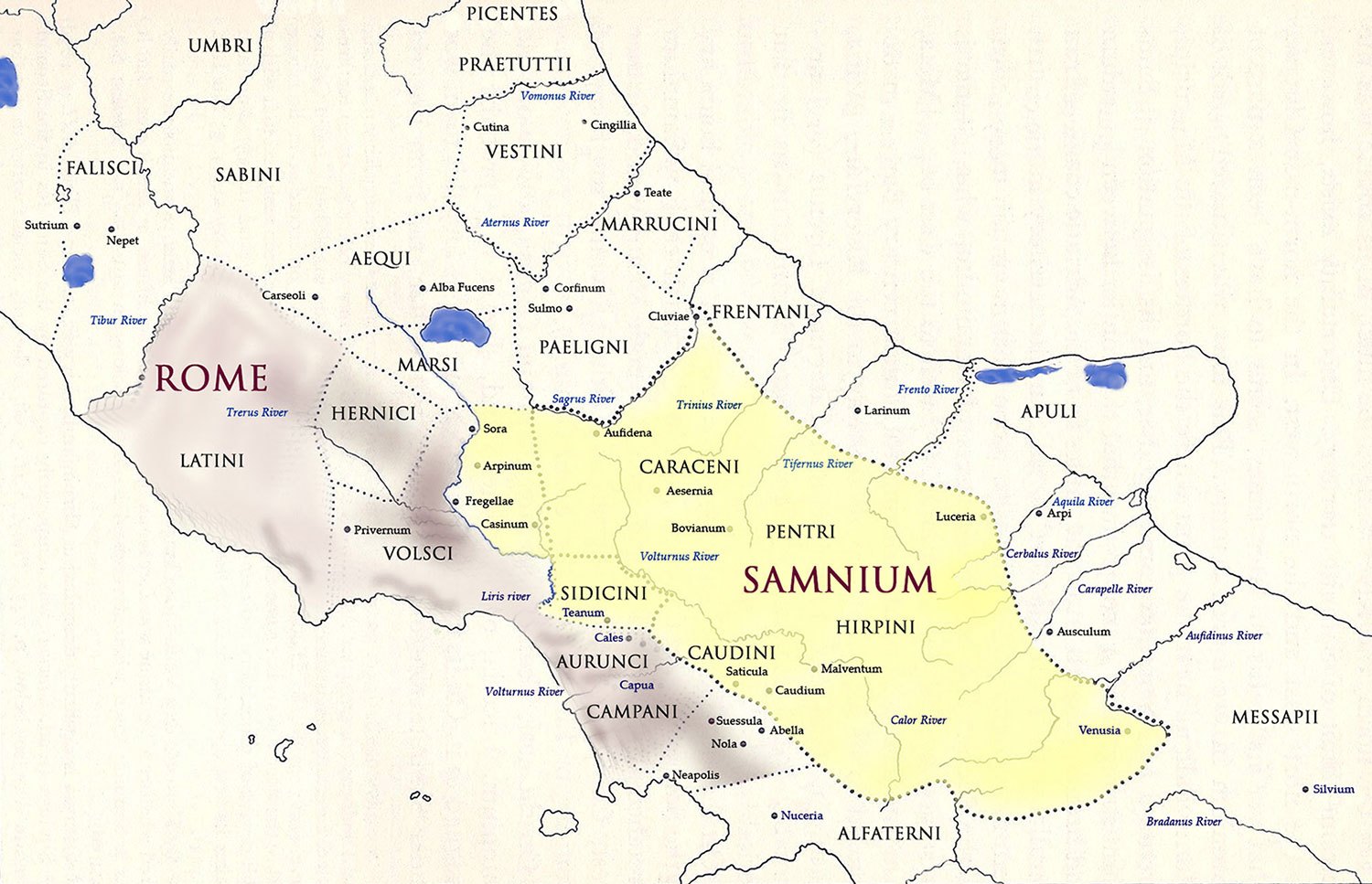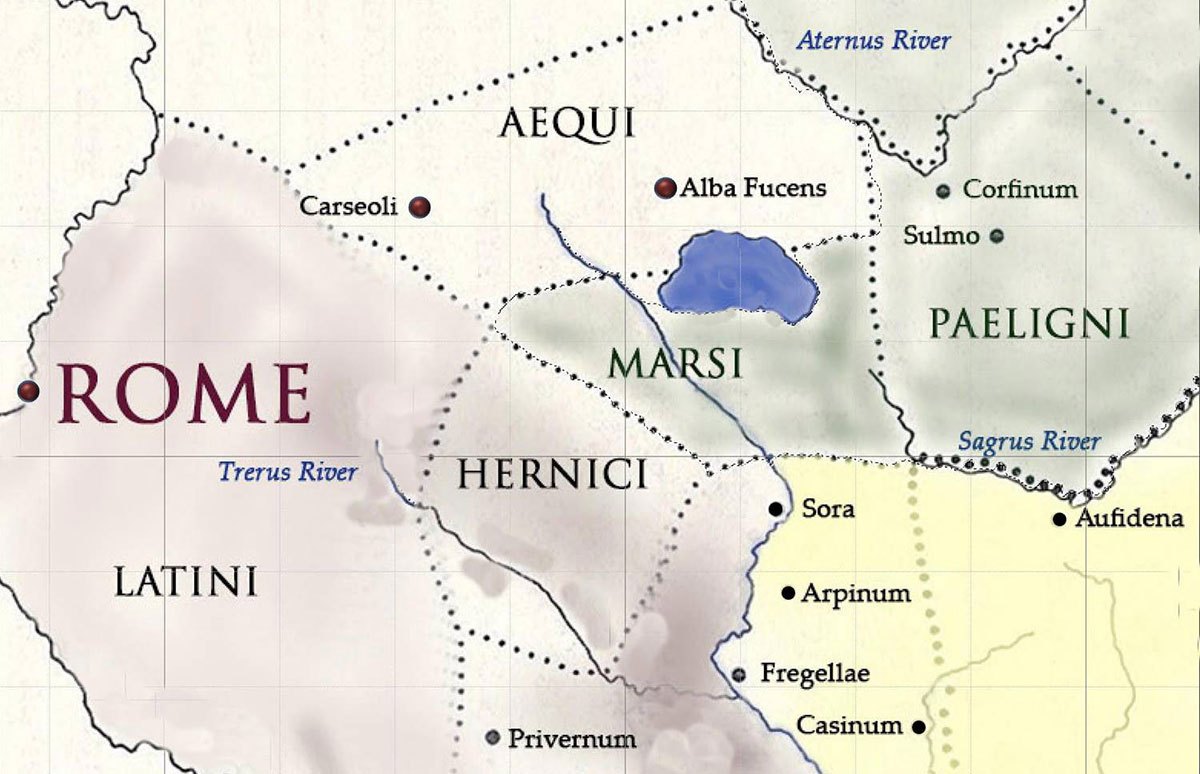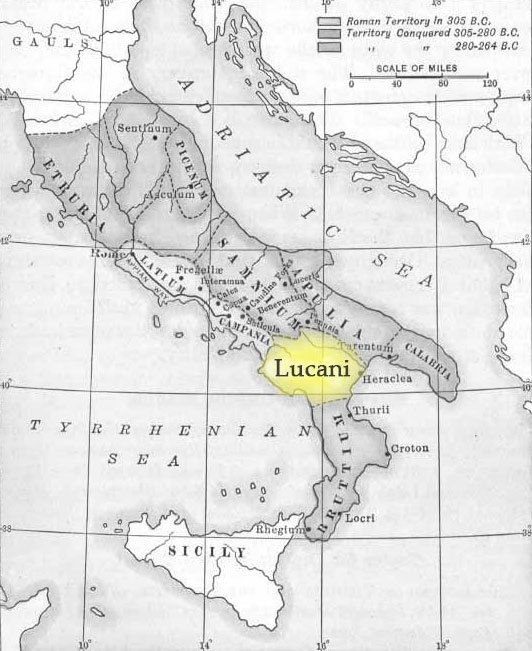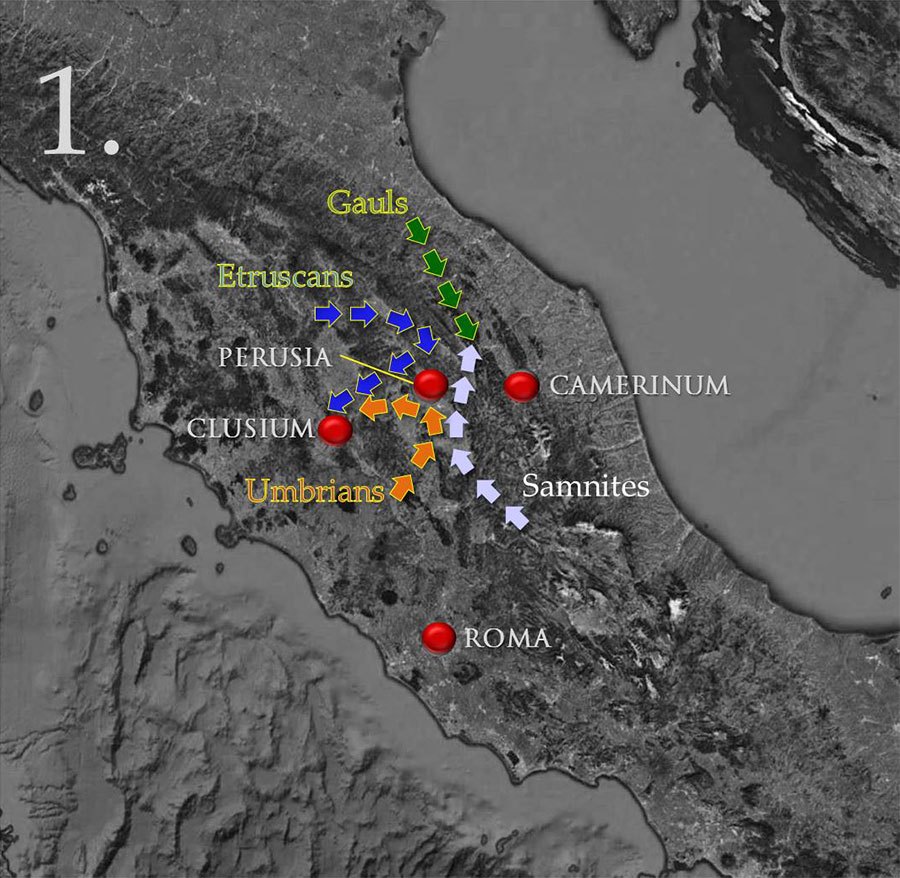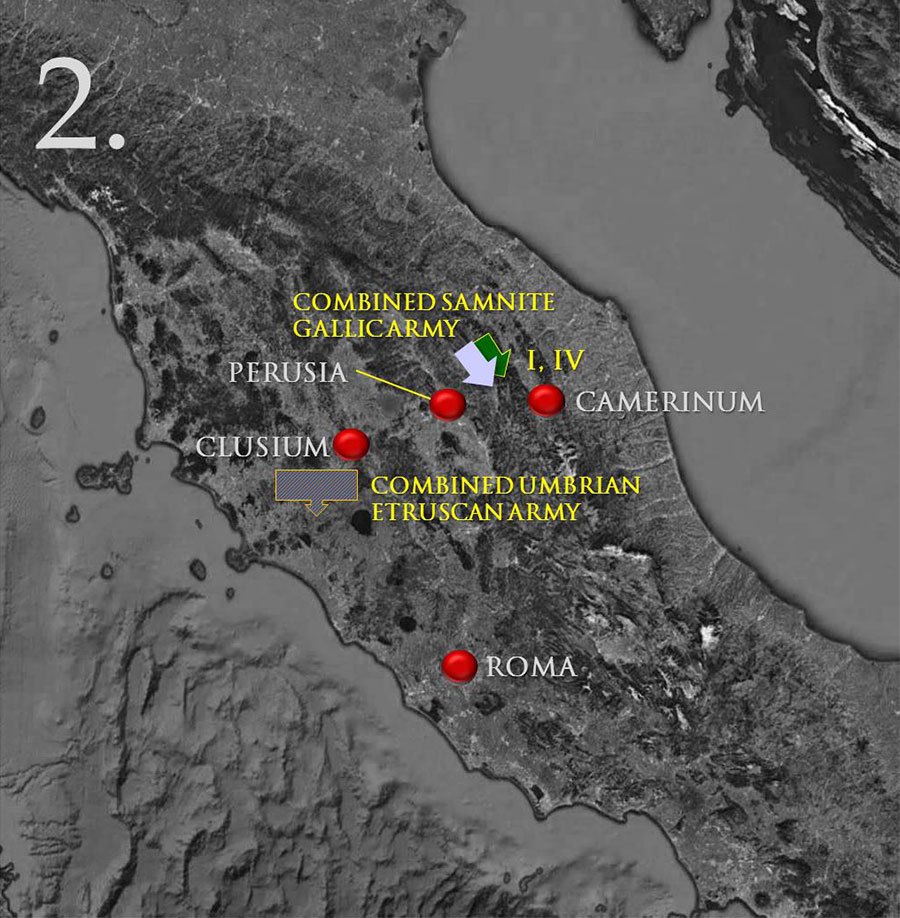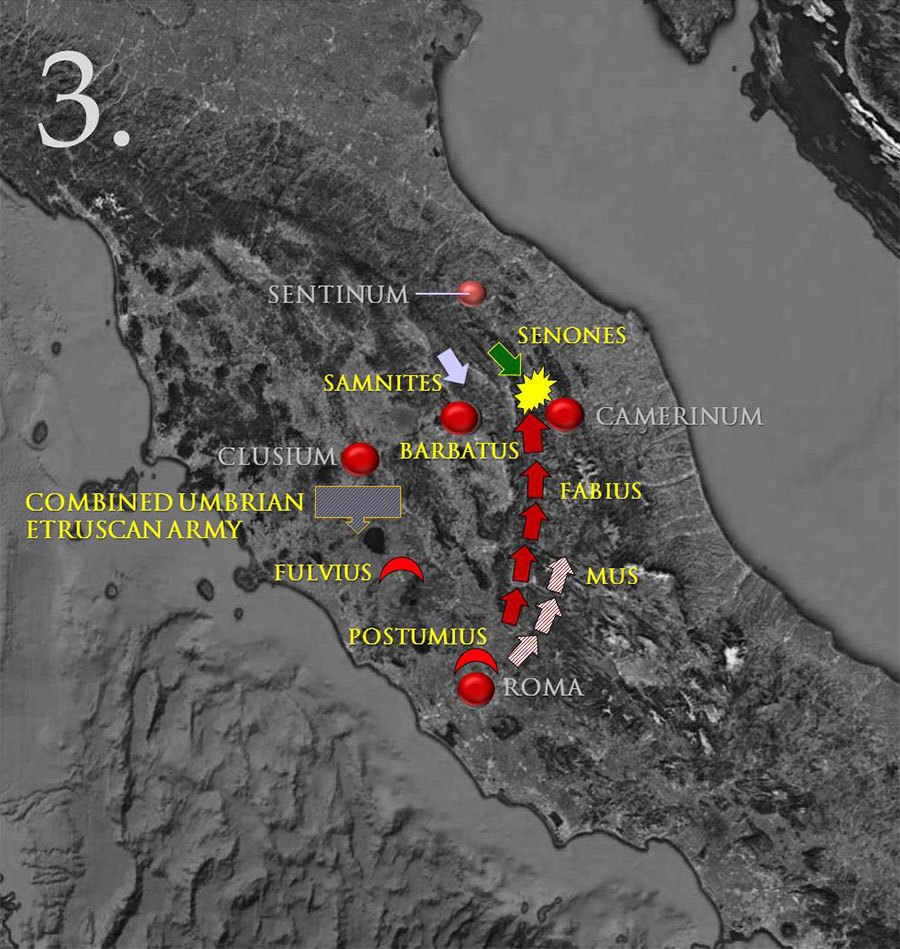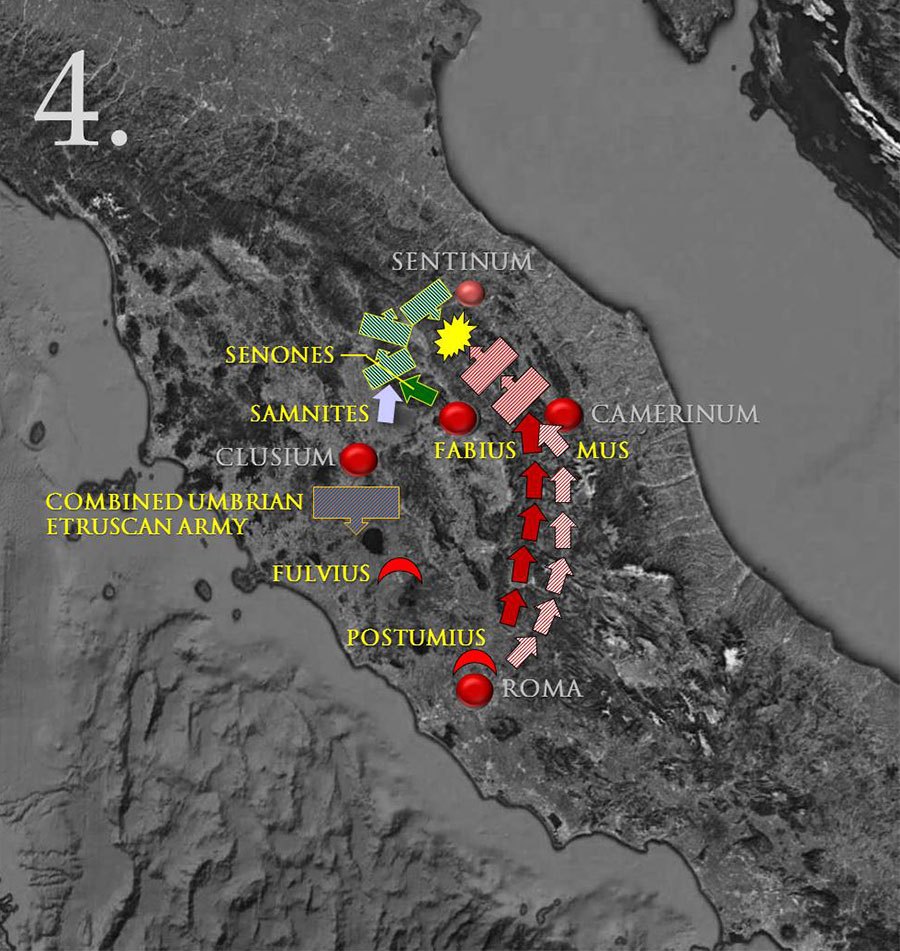300-290 BC
Third Samnite War
Diplomatic (and other kinds of) maneuvering between the Second and Third Samnite Wars
304-298 BC
Even as the Second Samnite War was winding down in 304 BC, both the Samnites and the Romans were maneuvering diplomatically, attempting to strengthen their strategic position vis-à-vis each other. There were also infrastructure moves—building of a consular road along the northern tier of Samnium, the planting of colonies in or near newly won territory—made by the Romans.
By 304-301 BC, the Romans had consolidated defensive alliances with the Marci, Paeligni, Marrucini, Frentani and Vestini. This cordon sanitaire separated the Samnites from potential allies like the Etruscans, the Umbrians and the Gauls in the north.
ET Salmon, Samnium and the Samnites, 1967, page 255.
Based upon map in E.T. Salmon, Samnium and the Samnites, 1967, page 25. Modifications based upon readings in Livy and Salmon.
Aequi eliminated as an independent nation.
The Romans confiscated Aequi lands and planted two colonies in their territory–Carseoli and Alba Fucens. Most of the towns were given Roman citizenship without the right to vote.
ET Salmon, Samnium and the Samnites, 1967, page 256.
At the same time the Romans absorbed Aeqium into the Roman body politic and the Aequi ceased to exist as an independent people. This completed the northwestern piece of the cordon sanitaire, isolating Samnium across the northern tier of the Italian peninsula (from the Western Tyrrhenian coast to the Eastern Adriatic coast).
But the Romans weren’t done. They provoked a fight with the Umbrian city of Nequinum, took it, and converted it into a Roman colony called Narnia in 299 BC. About this time, the Gauls, accompanied by a noticeable number of Etruscans, raided Latin territories. The Romans responded by devastating Etruscan lands. The Etruscans made no response which suggests that they didn’t feel strong enough to do so.
The Southern boundary of Samnium
The Lucanians, an Oscan-speaking people who lived along the southern border of Samnium, were at war with Taras (Tarentum), which had hired a Spartan mercenary general to lead its army. The Spartan eventually left Italy. The Lucanians were then attacked by the Samnites.
298 BC
The Lucanians, who were divided between pro-Roman and pro-Samnite factions, invited the Romans to join them in a defensive alliance. The Romans accepted and this put them into direct conflict with the Samnites. So began the third Samnite war.
Lucania.
297 BC
Nothing of consequence happened in this year. No major battles were fought and no major cities were taken.
296 BC
The Roman Senate grew impatient with the inaction. Consequently, two consuls were given proconsular power and kept their commands; Fabius Rullianus in the Liris valley and Decius Mus in Apulia.
E.T. Salmon, Samnium and the Samnites, 1967, page 262.
Decius Mus was mostly active in the area east of Venusia. We don’t hear anything specific about Rullianus at this point. In the north, Gellius Egnatius, a Samnite commander, attempted to join the Etruscans, Umbrians and Gauls in an alliance against Rome. He broke out of Samnium into Etruria. The Romans, surprised by Egnatius’ move, called an emergency mass levy for the defense of Rome. They also brought up forces from northern Campania. This allowed another Samnite army to descend upon Falernian and Auruncan lands, plundering and wreaking havoc. However, the Proconsul Rullianus was able to force the invaders back and stabilize the situation.
The Romans were prepared for a big push in 295 BC, so they kept their commanders and their armies in the field that winter.
295 BC
While the Senate was preparing for a big push in the north, Rome was struck by plague. The outbreak lasted through 292 BC and must have significantly impaired the Roman ability to levy troops for what was a very serious challenge in the north.
The following Commanders were elected or appointed for 295 BC
- Publius Decius Mus (consul)
- Quintus Fabius Rullianus (consul)
- L. Volumnius Flamma (proconsul)
- Appius Claudius Caecus (praetor)
- L. Cornelius Scipio Barbatus (propraetor)
- Cnaius Fulvius Maximus Centumalus (propraetor)
- Postumius Megellus (propraetor)
Allied Armies Concentrate near Perusia
Allied Armies Concentrate.
In 295 BC, the Romans put 100,000 men at arms into the field. The allied nations—Samnites, Gauls, Etruscans and Umbrians—have a larger number. The Samnites under Egnatius march north from Samnium into Etruria and meet the Gauls (Senones tribe) who march south from Gaul to Perusia. The Umbrians march north from Umbria and the Etruscans concentrate at Perusia. Then word comes of a Roman army heading toward Clusium, so the Umbrians and Etruscans concentrate their armies there.
Allies positions after redeployment due to Roman threat
Allied armies after redeployment.
Because of the Roman threat to western Etruria, the Umbrian and Etruscan forces redeploy to Clusium. This significantly reduces the numbers of the eastern allied army leaving only the Samnites and Gauls. Nevertheless, two substantial allied armies now protect the north. One threatens Rome-friendly Camerinum in the Northeast and another army protects Western Etruria and poses a potential threat to Rome itself. However, of the two allied armies, the Samnite-Gallic army is considered the more formidable force.
Gauls Defeat Barbatus at Camerinum
Gauls Defeat Barbatus at Camerinum.
Barbatus leads a picked force from Fabius’ army and advances toward Camerinum where it encounters a strong Gallic army. Barbatus is defeated. Presumably, Fabius continues north and does not engage the enemy which outnumbers him significantly. In the meantime, Mus marches north (with another two Roman and two allied legions) in order to strengthen Fabius.
Combined Roman army (Mus and Fabius) defeats combined army of Samnites and Gauls at Sentinum
Roman Victory at Sentinum.
After Mus joins up with Fabius around Camerinum, the combined force heads north and confronts the combined Senones (Gallic)-Samnite army at Sentinum. Mus, faces the Gauls and their chariots on the Roman left while Fabius faces the Samnites on the Roman right. Mus and Egnatius die in battle. The Gauls maul the Roman left but the Roman right overcomes the Samnites and then rolls up the Gallic flank. The Romans score a great victory.
ET Salmon, Samnium and the Samnites,1967, page 267.
294 BC
After their victory at Sentinum, the Romans engaged in a holding action against the Samnites and proceeded to consolidate their gains in the north. They accepted the submission of the Umbrians and defeated the Etruscans. So the northern tier of Italy was neutralized. Unfortunately, elsewhere, Roman arms suffered a reverse; in the east near Luceria and in the west in the Liris basin. However, the presence of Roman colonies at Sora and Interamna Lirenas, prevented a Samnite breakthrough into northern Campania.
293 BC
A Samnite levy for this campaigning season also included the outfitting of an elite corps called the Linen Legion. The Samnite effort would be in the northwest, with forces based on the fortresses of Cominium and Aquilonia. The Romans had consular armies depart from the Roman colonies of Interamna Lirenas and possibly Teanum Sidicum. The Roman armies plundered Samnite territory and took some small towns until they arrived at Cominium and Aquilonia, two fortresses that were 20 miles apart. The two commanders agreed to attack those fortresses on the same day. The Samnite force at Cominium was tied down by the Roman attack. The Linen Legion was cut to pieces at Aquilonia. The Roman commanders of these two armies, Papirius Cursor and Carvilius Maximus were awarded triumphs. This double Samnite defeat left vulnerable the western frontier of Samnium. The Romans were quick to exploit their advantage. They took Saepinum as well as Velia, Herculaneum and Palumbinum.
292 BC
In this campaign the Caudini (a major Samnite tribe) were knocked out of the war.
291 BC
The Pentri and Hirpini (two other major Samnite tribes) are defeated.
290 BC
Military operations in Samnium are wound up. The Samnites sign a treaty with Rome.
“By becoming allies of Rome the Samnites were obliged henceforth to accept foreign policy imposed on her, to supply troops on demand, and to abstain from acts of violence against their neighbors.”
E.T. Salmon, Samnium and the Samnites, 1967, page 279.

